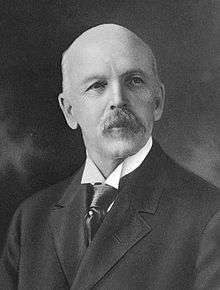Augustus Stinchfield
Augustus W. Stinchfield (December 21, 1842 – March 15, 1917) was an American physician and one of the co-founders—along with Drs. Charles Horace Mayo, William James Mayo, Christopher Graham, E. Starr Judd, Henry Stanley Plummer, Melvin Millet and Donald Balfour—of the Mayo Clinic in Rochester, Minnesota.
Augustus Stinchfield | |
|---|---|
 | |
| Born | December 21, 1842 |
| Died | March 15, 1917 |
| Alma mater | Bowdoin College University of Michigan |
Life and career
Stinchfield was born in Phillips, Maine and received his early education in the nearby town of Strong. He moved from Maine to Wisconsin as a young man and, in 1864, enlisted as a private in Company F of the Thirty-ninth Wisconsin Volunteer Army. After the Civil War, he attended Bowdoin College and the University of Michigan. He received his M.D. degree from Bowdoin College in 1868. After practicing medicine in Verona, Missouri, as well as Dundas and Eyota, Minnesota, Stinchfield was asked by William Worrall Mayo to join the Mayos' practice in 1892. William Worrall Mayo was retiring and wanted a mid-career physician to balance the growing private practice.
While the Mayo brothers excelled in surgery, Stinchfield was well qualified to handle the non-surgical duties of the practice. When Will Mayo approached the remaining partners in 1915 about changing the private practice to a not-for-profit practice, Stinchfield was the first to sign the agreement. When the remaining partners signed the transfer papers, this gift insured the long-term survival, development and growth of the Mayo Clinic.
The living great-grandson of Dr. Stinchfield, Douglas Anderson, continues to work at Mayo Clinic in the department of information technology.
Bibliography
- "Psychological influences in health and disease", Tr. Minnesota State Medical Society, 1875, pp. 30–40
- "Sciatic neuritis", Northwest. Lancet, 14:184, 1894
- "Gastritis", Northwest. Lancet, 15:321–324, 1895
- "The treatment of pleurisy", Northwest. Lancet, 16:395, 1896
- "Nervous syndroms of Bright's disease", Northwest. Lancet, 16:449, 1896
- "Bronchitis and its complications", Northwest. Lancet, 17:452–455, 1897
- "Cardiac dilation", St. Paul Med. Jour. 2:610–615, 1900
References
- Clapesattle, Helen. The Doctors Mayo, University of Minnesota Press (1975). ISBN 0-8166-0465-7
- Mayo Clinic, Physicians of the Mayo Clinic and the Mayo Foundation, University of Minnesota Press, 1936
- Mayo Medical School at www.mayoclinic.org